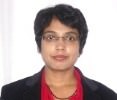Iasa’s Contributor of the Month & Member Spotlight
The Contributor of the Month & Member Spotlight are part of a new initiative for Iasa that will highlight specific members each month that have gone above and beyond to provide valuable contribution to their global community.
To find out more, please see our Content Contribution page for further information.
Contributors of the Month
 MAYA MORE
MAYA MORE
Senior SME, Architecture and Technology
I joined Iasa Global in March 2014 as an individual full time member, so it is a year now. What do you do, and how long have you been doing it? I am senior architect with a large private oil and gas major in India. I took up this position six months ago and am part of a team that is setting up the Enterprise Architecture function for the group. Prior to this role, I spent nineteen years with two major Indian IT services and consulting firms travelling to different countries for client projects. In 2004, I moved from handling software design and project management to a full time solutions architect career track. I now specialize in business technology strategy, application architecture and information architecture, and work in business transformation initiatives and reference architecture development.
Q: Why did you decide to contribute to Iasa and what does your involvement look like?
I initially signed up for IASA membership in order to attend architect training and pursue the CITA certification. I found on the Iasa Global website that there are multiple platforms offered to members to contribute. I started initially with blogs, but seeing the volunteer calls for the guidebook, moved to contributing to capabilities for the Business Technology Strategy pillar. My initial submissions brought me positive feedback from IASA’S BOE Committee chair, Miriam Grace. I went on to take up more capabilities areas as we were looking for authors to complete the guidebook. On an average I spent 3-4 few hours every weekend and completed five different capabilities. I am currently working on the training modules to accompany the capabilities guidebook which is likely to take up some more effort. I also continue to sign up for trainings and certifications. I completed my CITA-F certification last July and plan to appear for CITA-A this fall.
Q: How has your involvement with contributing in Iasa Global benefited you?
Contributing to Iasa and being a member has benefited me in many different ways. I get to enhance my knowledge looking up past experiences, researching and validating the information I eventually condense for the capabilities. Getting ISA BOE’s direct input and feedback from peers is great validation of my experience. Working alongside peer architects from premier organizations worldwide, has also significantly expanded my professional network. And of course, I have made new friends across the globe as well.
Q: Why is it important for other organizations or individuals to join and contribute to Iasa Global?
If you look at the growing complexity and inter-connectedness of systems today, against the backdrop of security threats, architecture specialization is becoming a necessity for organizations across the world. Yet, I know from experience of the wide disparity and confusion on the architect’s role and sometimes the maturity of architecture itself. Iasa recognizes architecture as a profession requiring a systematic body of skills and has a well-defined body of knowledge and career ladder defined by the collective efforts of practicing architects over the past decade. Second, Iasa recognizes the role of architects as a bridge between business and IT and the ITABoK equips architects with the tools and knowledge that are requisite to that role. As a vendor, industry or framework neutral body, it is a great peer platform for career architects. Contributing will help grow and consolidate a shared global body of knowledge that can be institutionalized across industries, similar to project management and quality practices.
Q: What are your hobbies?
I like to read as well as write in my spare time. I also like to cook and experiment with new cuisines and recipes.
Q: What book are you currently reading?
A lot of technical books are taking up my reading time at the moment, so for leisure, I am re-visiting some of my old favorites – Jerome K Jerome’s Three Men in a Boat and Three Men on the Bummel. I am also reading Poems of William Blake.
Q:What social networks do you belong to?
I use Facebook to stay connected with friends, family and follow personal interest groups. I use LinkedIn for professional networking but prefer memberships with professional associations like Iasa and IEEE for networking and to follow developments in architecture and technology. I also contribute to online travel and book communities.
Q: Any last thoughts?
I would like to end with sharing two quotes I have heard from fellow architects at work and that highlight the human dynamics aspect of an architect’s role. First is, “The most important tool for an architect is a box of chocolates”. And the second, “Architects should be good at what they do. But great architecture is everyone’s responsibility”.
Phil Wheat
Founder, Drone Labs,LLC.
I’ve been presenting and sponsoring IASA for over 8 years now, and look forward to many more going forward.
Q. What do you do, and how long have you been doing it?
I create solutions. Some of those solutions are in code, some are in hardware, some are with people. But mostly with code and hardware.
Q: Why did you decide to contribute to Iasa and what does your involvement look like?
I’ve been lucky enough to be able to support with sponsorship, locations, and speaking engagements. It’s been a great time working with the various organizational and community members during this time.
Q: How has your involvement with contributing in Iasa Global benefited you?
Working with IASA has been great in spotlighting projects and processes that I’ve worked on that needed to be socialized and emulated. It has also been a great way to keep in contact with very talented people and their works.
Q: Why is it important for other organizations or individuals to join and contribute to Iasa Global?
While there are quite a few organizations in the industry that can help technologists with the “How”’s of their careers, IASA is where the “Why”’s are reviewed. And if you’re not looking at the “Why” then you’re very likely to not pick the best “How.”
Q: What are your hobbies?
I build things. Robots, Aircraft, Buildings, etc. I’m currently on a big push around all things Radio.
Q: What book are you currently reading?
“Attack on Pearl Harbor: Strategy, Combat, Myths, Deceptions “
Q. What social networks do you belong to?
I belong to pretty much all of them, but I generally just pay attention to Facebook for personal items and LinkedIn for professional ones.
Q: Any last thoughts?
Working with IASA has been a great experience – I do hope more people can come out to our events and participate in the conversations and content we’re doing.
 Phil Helm
Phil Helm
Principal Software Engineer, Metlife
President, Iasa Raleigh Chapter
Q: What was your motivation to start the chapter?
I have a passion for quality and knowledge, and Iasa fulfills both. I also saw a shortage of technology leadership and collaboration in the Triangle. There is an opportunity to do something very special in this area.
Q: What is the vision of the chapter for the IT architecture profession in your local area?
To grow the profession and the individual architect. The Triangle is a rapidly growing technology hub and will need quality architects to fill those gaps. Both the practitioner and the student will need a strong architecture skillset, and this chapter intends to help develop it.
Q: What excites you/your members about Iasa and the chapter opportunities?
What are you and your member’s expectations?
I think exchanging ideas and best practices with the community in an agnostic way is very exciting. It is one thing to read a book about architecture; it is quite another to hear a practitioner describe what works and what does not in the real world.
I would expect a member to learn something new and valuable on every single interaction with the chapter. Events should be engaging, though provoking, and most of all create a higher standard for architecture.
Q: What are the plans for the chapter in terms of activities (meetings, training, programs etc.)
If you have specifics please include location, date, agenda etc.
We have some tentative plans to hold a Triangle area kickoff meeting in August, a “Day in the Life” architecture panel at UNC in October, as well as several use case workshops through the end of 2015 based on the five pillars of ITABoK.
Q: What else do you want to share with us for the news article?
We want this chapter to serve the architects and the engineers. Anything we do as a chapter leadership team needs to reflect the needs and wants of our members. We are open to any and all suggestions on how to make this chapter successful.

 Daniel Akenine
Daniel Akenine






